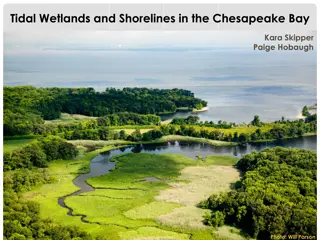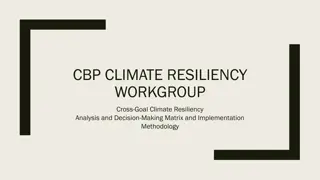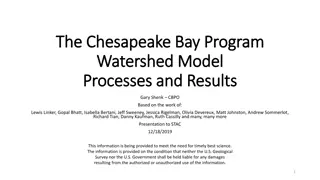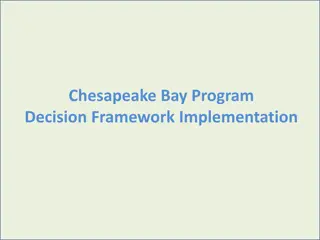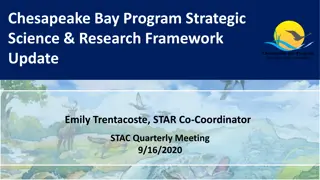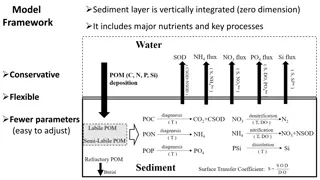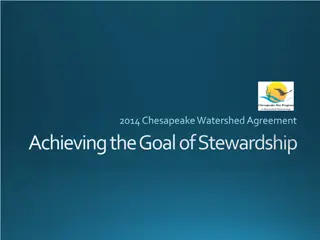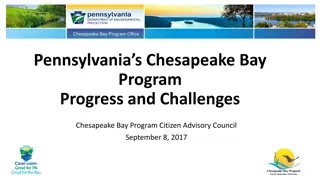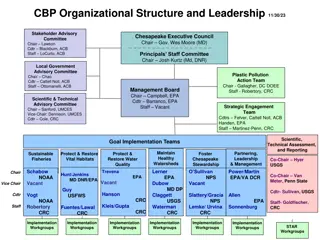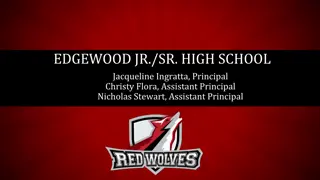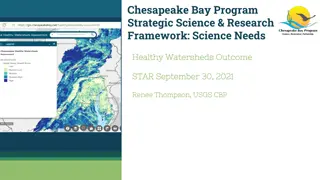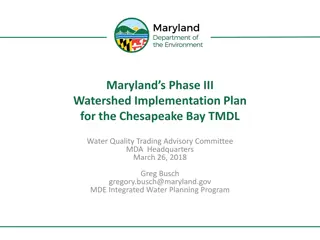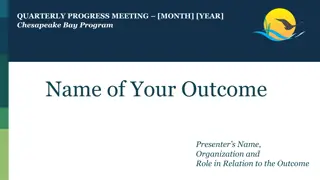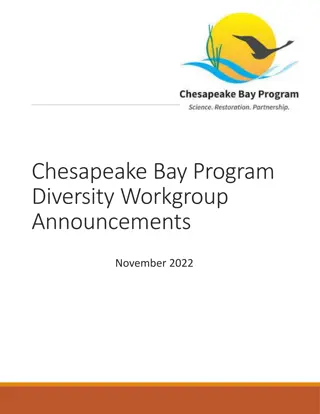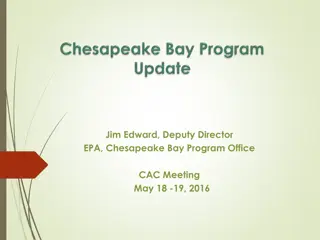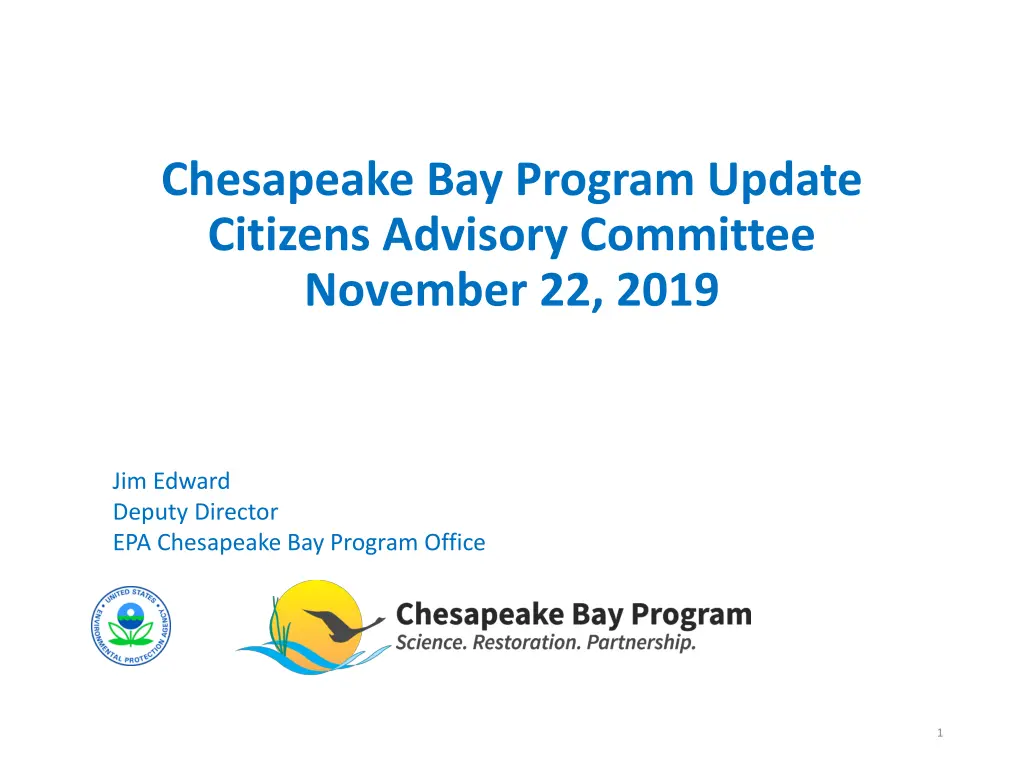
Chesapeake Bay Program Updates and Recommendations
Stay informed with the latest updates from the Chesapeake Bay Program, including milestones, budget updates, and recommendations for water quality goals. Learn about the Citizens Advisory Committee's input on numeric commitments and the EPA's reactions to these recommendations. Discover the importance of two-year milestones and accountability in achieving watershed implementation plans.
Download Presentation

Please find below an Image/Link to download the presentation.
The content on the website is provided AS IS for your information and personal use only. It may not be sold, licensed, or shared on other websites without obtaining consent from the author. If you encounter any issues during the download, it is possible that the publisher has removed the file from their server.
You are allowed to download the files provided on this website for personal or commercial use, subject to the condition that they are used lawfully. All files are the property of their respective owners.
The content on the website is provided AS IS for your information and personal use only. It may not be sold, licensed, or shared on other websites without obtaining consent from the author.
E N D
Presentation Transcript
Chesapeake Bay Program Update Citizens Advisory Committee November 22, 2019 Jim Edward Deputy Director EPA Chesapeake Bay Program Office 1
Overview Numeric Two-Year Milestones Methodology BMP Verification Requests from Water Quality Goal Implementation Team (GIT) EPA Budget Updates
Chesapeake Bay Program (CBP) partnership Water Quality Goal Implementation Team (WQGIT) Recommendation to the Management Board (October 17, 2019) State and federal agencies will be held accountable to their short-term (i.e., 2-year) numeric goals through a biennial evaluation of progress compared to the straight-line trajectory of necessary reductions to the 2025 Phase III planning targets or federal agency planning goals. If a state or federal agency so chooses, numeric 2-year milestones could be developed for the purpose of following an alternative (i.e., non-straight- line) trajectory to 2025. Using this approach, the expectation for states and federal agencies to develop numeric 2-year milestones under the Bay TMDL Accountability Framework could be eliminated (pending PSC approval). The expectation to develop programmatic milestones will remain the same. Sector-scale numeric progress information will continue to be made available by the CBP partnership.
CAC Letter to Water Quality GIT Leadership (October 25, 2019) CAC believes that numeric commitments support (1) intermittent ability for adaptive management and political accountability for each source sector, and (2) more transparency and stakeholder understanding on short term progress so the public can encourage financial/legislative support for accelerated action. Continuing numeric commitments aligns with the original intent of the two year milestones as stated in the November 4 2009 EPA Letter to PSC Outlining EPA s Expectations for Watershed Implementation Plans. Numeric two-milestones also support the Bay Program partnership s Accountability Framework as stated in the Dec 29, 2009 EPA Letter to PSC: EPA will also monitor whether a jurisdiction has implemented point and nonpoint source controls to meet the basin-jurisdiction loading targets identified in its two- year milestones . The partnership has recognized the co-benefits of BMPs, especially the practices where progress lags far behind like forest buffers and wetlands. If the decision is made that a change is necessary, CAC recommends you look at alternatives such as aligning the reporting deadlines for the numeric and programmatic commitments or selecting the priority BMP numeric commitments that are critical to achieving the jurisdiction s WIP in each source sector.
Initial EPA Reactions to WQGIT Recommendations Although the partnership is considering eliminating the expectation of numeric two-year milestone targets, we will still have numeric targets through the straight line trajectory. EPA will use the annual numeric BMP submissions to determine if the jurisdictions remain on that trajectory between now and 2025. EPA, in coordination with and approval of the Chesapeake Bay Program partnership, established a straight-line trajectory between 2009 and 2025 for each Bay jurisdiction that demonstrated the expected level of pollutant load reduction to be achieved on an annual basis in order to meet its respective Bay TMDL targets. EPA measures the jurisdictions annual progress submissions against this straight-line trajectory to determine if the jurisdictions are on track to meet their targets by 2025. EPA will be providing each of the jurisdictions with annual and two year milestones numeric targets based on their trajectory.
Revised WQGIT Recommendations to the CBP Management Board regarding the development of numeric two-year milestones under the Chesapeake Bay TMDL Accountability Framework (November 12, 2019) States and federal agencies will be held accountable to their short-term (i.e., 2- year) estimated numeric loads through a biennial evaluation of progress compared to the straight-line trajectory of necessary reductions to the 2025 Phase III planning targets or federal agency planning goals. If a state of federal agency so chooses, numeric 2-year milestones (i.e., full CAST scenario) could be developed for the purpose of following an alternative (i.e., non-straight-line) trajectory to 2025. Using this approach, the expectation for states and federal agencies to develop CAST estimated numeric 2-year milestones under the Chesapeake Bay TMDL Accountability Framework will be voluntary. The expectation to develop programmatic milestones will remain.
Revised WQGIT Recommendations to the CBP Management Board regarding the development of numeric two-year milestones under the Chesapeake Bay TMDL Accountability Framework (November 12, 2019) (Continued) In lieu of voluntarily developing CAST estimated numeric milestones and to improve the link between actual implementation and programmatic commitments, states and federal agencies will include two-year numeric commitments in their programmatic milestones for at least 6 BMPs, selected by each state or federal agency, that are closely linked to programmatic commitments, including those that are key to achieving the 2025 goals. Additional measurable metrics like dollars committed and number of staff hired could also be included. (NEW) Sector-scale numeric progress information will continue to be made available by the CBP partnership through established accounting metrics (e.g., annual progress evaluation) and may be used by EPA as another indicator of progress toward the 2025 goals.
Water Quality Goal Team Requests to Chesapeake Bay Program Management Board re: BMP Verification Program Changes Letter from WQGIT leadership to MB Chair Dana Aunkst on September 26, 2019 Requests to consider alternatives on the following: 1. Timing and format of annual updates to jurisdictions verification program plans 2. The process and timing for review, approval and publication of the annual updates to jurisdictions verification program plans and QAPPs to ensure the equitable and consistent application between states 3. Procedures for review and approval of any additional data collection and verification expectations that are beyond those included in jurisdictions approved verification program plans 4. Improving the reporting of verification actions that remove or discount reported BMPs from the model 5. The current all-or-nothing approach to BMP reverification. (The partnership should explore the potential for partial credit, or variable duration or otherwise removed for verification.) 6. Make recommendations on procedures for updating or establishing BMP credit durations 7. Review BMP back-out and cut-off procedures 8. Determining and including an estimate of the costs of verification for each BMP in CAST
Water Quality Goal Team Requests to Chesapeake Bay Program Management Board re: BMP Verification Program Changes Two additional issues of concern that were raised by the WQGIT: The process and methods used by the CBPO modeling team to evaluate annual progress data submissions Ensuring jurisdictions have full access to all federally cost-shared conservation practice data and enhancing reporting of federally cost-shared practices.
Potential Management Board Response to WQGIT May be premature to re-open and formally modify the verification protocols after just the first year of verification reporting. Prior to the memo s release, the CBP partnership s Watershed Technical Workgroup addressed the concerns (noted as #7 in the memo) with the back-out and cut-off procedures through additional documentation in CAST and simplified NEIEN error reports. EPA will provide further documentation of its procedures for conducting reviews associated with the annual submissions of BMP data for the progress assessments, including a detailed description of how these procedures are consistent with the CBP partnership s 2014 BMP verification framework document.
Potential Management Board Response to WQGIT (cont) The CBP partnership could explore taking the following actions to address other concerns identified by the WQGIT: EPA may revisit and document the schedule for submissions of updates to the jurisdictions BMP Verification Program Plans. Further discussion amongst the CBP partnership is needed to determine the appropriate forum and group to explore any modifications to the BMP credit-life and duration protocols that were established by the BMP Verification Committee. STAC should work closely with the jurisdictions in that process but any revisiting and potential refinements of the BMP verification protocols should be handled by the CBP partnership s scientific experts.
EPA Budget Update Continuing Resolutions through November 21 (and December 20?) Current(FY19) EPA-CBP Budget - $73 million House Bill (FY20) $85 million (+ $12 million increase) + $6 million increase for Innovative & Small Watershed grants + $6 million for most effective basins Senate Bill (FY20) $78 million (+ $5 million increase) + $5 million increase for Innovative & Small Watershed grants
Questions? Learn more: www.chesapeakebay.net www.chesapeakeprogress.com Facebook: Chesapeake Bay Program Twitter: @chesbayprogram Instagram: @chesbayprogram Jim Edward, Deputy Director EPA-CBPO 410-267-5705 edward.james@epa.gov 2019 DoD Chesapeake Bay Commanders Conference One Mission Shared Leadership Continuing Commitment - 13 -


